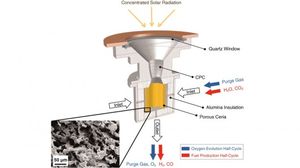
When I talk of solar energy having "Moore's Law" effects, you might think I'm describing greater efficiencies for polysilicon panels (they're made with the same process used to make semiconductor chips) or the math that multiplies production as new systems are installed alongside old ones.
But I'm really thinking of something else, the rapid breakthroughs possible from using the computer processing power Moore's Law has made some abundant, and the trained minds being produced in ever-greater quantities around the world.
That's what gives me hope for 2011 and beyond. Here's one example.
Cerium oxide is a fairly common substance in industry. It is used as a catalyst in self-cleaning ovens, it's used in ceramics, it can sensitive photosensitive glass, and it has even been considered as a component for sunscreens, since it absorbs ultraviolet light but is transparent to visible light.
A CalTech team with Swiss help built what they call a small solar reactor with it. Instead of producing hydrogen in a two-step process (make electricity, use that to split water), the reactor does it in one go. Light is focused through a quartz window into a chamber holding lined with porous cerium oxide, water and carbon dioxide are pumped in, and what comes out is water and carbon monoxide.
The prototype is ridiculously inefficient. What's exciting is how this mimics how plants work. It cuts out the electric middle-man, so it can be made very efficient. We're talking, potentially, orders of magnitude more efficient.

Breakthroughs like this don't go into the market right away. It takes time to fine-tune a prototype, then to find a way toward production. On a large scale I could see a plant using this technique situated in Texas, near the water, producing hydrogen for ammonia pipelines and to run fuel cells for industry.
But that's all for the market to decide. Meanwhile, have a Happy New Year.











Hi, thanks for this interesting post. I was actually looking for more Solar Energy Infomation, and in a way this post helped me,though I think it was all about solar panels. I’ve followed a lot of your posts, looking forward to more post to come.
Hi, thanks for this interesting post. I was actually looking for more Solar Energy Infomation, and in a way this post helped me,though I think it was all about solar panels. I’ve followed a lot of your posts, looking forward to more post to come.
Make Electricity
Dana Blankenhorn: Cerium breakthrough opens new path of progress